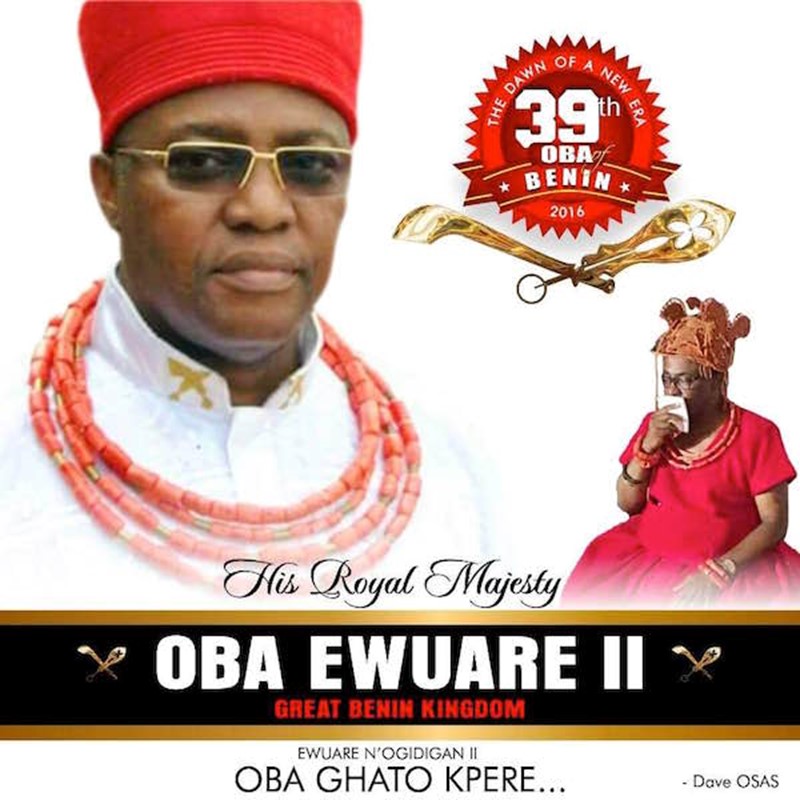
The Benin Crown Prince, HRH Ehenede, formerly the Edaiken of Uselu, has been named HRM Oba Ewuare II at Use, the traditional royal naming site in Benin Kingdom. The new Oba would be presented to the public today in a grand ceremony.
Ewuare was the name given to one of the greatest Obas of Benin Kingdom who ruled Benin Kingdom from 1440 to 1473 and transformed the city from a small hitherto conflict-ridden kingdom into a great well organized empire of about 500 towns and villages, conquering over 201 new towns which were annexed into the kingdom.
Formerly known as Prince Ogun, Oba Ewuare (now to be addressed as Oba Ewuare I), was initially denied the throne as his brother usurped power and he was banished from the land.
{module_webapps id="41638" filter="item" itemId="13647211"}
How did Oba Ewuare I ascend the throne of Benin Kingdom?
Oba Ohen reigned in Benin from 1334 - 1370. The Iyase of Benin was murdered during his reign. Serious issues came up in the kingdom as a result of the murder of the Iyase. A rebellion started in Benin kingdom that brought the reign of Oba Ohen to an abrupt end. The people stoned him to death. Oba Ohen was succeeded in turn by four of his sons. Oba Egbeka 1370 CE, Oba Orobiru, Oba Uwaifioku and finally Oba Ewuare I.
Oba Ewuare I (Ogidigan or The Great) reorganized the kingdom, reconciled all the warring factions, consolidated, developed, and expanded the kingdom through innovative leadership ideas, closely knit, disciplined community organization, warfare, and conquests. Ewuare became king in a violent coup against his brother Uwaifiokun which destroyed much of Benin City by fire. After the war, Ewuare rebuilt much of the city of Benin, reformed political structures in the kingdom, greatly expanded the territory of the kingdom, and fostered the arts and festivals. He left a significant legacy and is often considered the first King of the Benin Empire and the greatest of the monarchs who has ever reigned in Benin.
Prior to the ascension to the throne of Oba Ewuare I, the Oba of Benin was limited in their power and authority by the Uzama, a group of hereditary chieftains throughout the kingdom.
{module_webapps id="41638" filter="item" itemId="13647212"}
The Uzama were able to appoint the Oba of Benin upon the death of an Oba and could limit any efforts by the Oba. The power of the Uzama then is similar to the power of the current Yoruba kingmakers who select a Yoruba monarch among royal families, oftentimes leading to serious conflicts.
The rise of Ewuare to a position of power is chronicled by various different oral history although his lineage and specifics of his rise are sometimes disputed. The generally accepted version of the history states that Ewuare was the eldest son of Oba Ohen.
A controversy arose after the deaths of Oba Ohen, Oba Egbeka and Oba Orobiru. Upon the death of Oba Orobiru, Prince Ogun sent his younger brother to Benin to see what was happening. The Uzama decided to appoint Prince Ogun but Uwaifiokun deceived the Uzama to appoint him as Oba claiming that his brother, Prince Ogun, was dead.
{module_webapps id="41638" filter="item" itemId="13647213"}
When Prince Ogun entered Benin and discovered that his brother had been made Oba, he masterminded a coup that led to the historic death of Uwaifiokun.
According to Historian Egharevba's version of the history, during a visit to the city during the reign of Uwaifiokun, Prince Ogun sought refuge with Chief Ogiefa. Chief Ogiefa left with a promise that he would support him but unknown to Prince Ogun, the chief left instruction with the slaves to keep him in a dried up well until he is back from the palace. Ewuare was then in a dried well the head slave of the chief, who was called Edo, let down a ladder into the well and advised Ewuare to escape. This was why Prince Ogun, when he became Oba Ewuare, renamed the land from Igodomigodo or Ibinu to Edo, which area is now called Benin City. Prince Ogun then took the name Ewuare meaning "the trouble has ceased" because the crisis was hopefully ended, and it did. Another version of the origin or meaning of the name Ewuare was "Iwuare" meaning "I also do not forbid" in response to the claim that Uwaifiokun had taken his title. He said "Iwuare" and the people reported his speech saying "Ewuare" meaning "He said he also do not forbid".
A major administrative development undertaken by Oba Ewuare I was reducing the power of the Uzama chiefs which were a limiting force on the Oba. Ewuare I removed their ability to appoint the Oba and instead adopted a clear succession rule going to the first-born son. In adopting this primogeniture lineage system, the authority of the Uzama as greatly decreased. In addition, to clarify the situation he Ewuare developed the Edaiken title for the oldest son to clearly establish the lineage. Ewuare also created two additional layers of administration in towns and villages with the creation of the Eghabho n'ore (town chiefs) and Eghabho n'ogbe (palace chiefs).{module_webapps id="41638" filter="item" itemId="13647214"}
Oba Ewuare led the Imperial Benin army against many of the Edo communities, living west of the Niger, Esanland, Afeimai, Delta and key Yoruba settlements like Akure and Owo. In towns that he took over, he quickly replaced the ruling elite with chiefs of his administrative system who were his allies. Ewu kingdom in present day Esan Central was established at this period when the Oba sent his viceroy, Prince Oza (called Ozaine in Ewu) from Igun to become the 1st Onojie of Ewu for the purpose of checking rebellious towns and villages of Esanland.
Oral history recounts 201 victories by Ewuare over the various cities and towns creating a large empire centered in Edo. During the reign of Oba Ewuare I, the capital city of the empire was rebuilt during Ewuare I with significant redesign. Around Benin City (then Edo), Ewuare I built significant walls and moats, large boulevards within the city, and clearly divided zones for different craft work. In addition, he rebuilt the palace and created a clear division between it and the rest of the capital city.{module_webapps id="41638" filter="item" itemId="13647215"}
Ewuare I was the Oba of the Benin empire when the Portuguese explorer, Ruy de Sequeira arrived Benin City in 1472. This established limited trade between the two empires, to be expanded greatly starting in the 1480s.
Ewuare I greatly expanded the city during his reign and was aided greatly in this through increased trade. Ewuare I is generally credited with expanding ivory and wood carving in the empire and the creation of Bronze heads for shrines to deceased Obas. In addition, Ewuare I began many of the royal decoration traditions involving coral.
During Oba Ewuare's reign as Oba of Benin, he ushered in the period of warrior kings, which lasted into the 16th century, traversing the reigns of the historic Obas Ozolua (the warrior), Esigie (the diplomat), Orhogbua (The Great Sailor and founder of Lagos) and Ehengbuda (the great son of Ehengbuda).The decision to name the former Crown Prince Ehenede as Oba Ewuare II is interesting. While very many royal observers believe that this Oba Ewuare II is more or less an incarnate of Oba Ewuare I by his outlook and the circumstances of his ascension to power, they however hope that this Oba should do more than Oba Ewuare I did, so that, as a Nigerian writer, Saintmoses Eromosele, stated in a publication, "This Oba should become, by the end of the day, Oba Ewuare II. While the first Oba Ewuare was the great, let this one become the greatest!".{module_webapps id="41638" filter="item" itemId="13647216"}
The following are the names of the Obas that have reigned or ruled in Benin Kingdom since the days of Eweka I.
1. Eweka I (1180–1246)
2. Uwuakhuahen (1246–1250)
3. Ehenmihen (1250–1260)
4. Ewedo (1260–1274)
5. Oguola (1274–1287)
6. Edoni (1287–1292)
7. Udagbedo (1292–1329)
8. Ohen (1329–1366)
9. Egbeka (1366–1397)
10.Orobiru (1397–1434)
11. Uwaifiokun (1434–1440)
12. Ewuare (1440–1473)
13. Ezoti (1473–1475)
14. Olua(1475–1480)
15. Ozolua (1480–1504)
16. Esigie (1504–1547)
17. Orhogbua (1547–1580)
18. Ehengbuda (1580–1602)
19. Ohuan (1602–1656)
20. Ohenzae (1656–1661)
21. Akenzae (1661–1669)
22. Akengboi (1669–1675)
23. Akenkpaye (1675–1684)
24. Akengbedo (1684–1689)
25. Ore-Oghene (1689–1701)
26. Ewuakpe (1701–1712)
27. Ozuere (1712–1713)
28. Akenzua I (1713–1740)
29. Eresoyen (1740–1750)
30. Akengbuda (1750–1804)
31. Obanosa (1804–1816)
32. Ogbebo (1816)
33. Osemwende (1816–1848)
34. Adolo (1848–1888)
35. Ovonramwen Nogbaisi (1888–1914)
36. Eweka II (1914–1933)
37. Akenzua II (1933–1978)
38. Erediauwa I (1979-2016)
39. Ewuare II (2016-)


